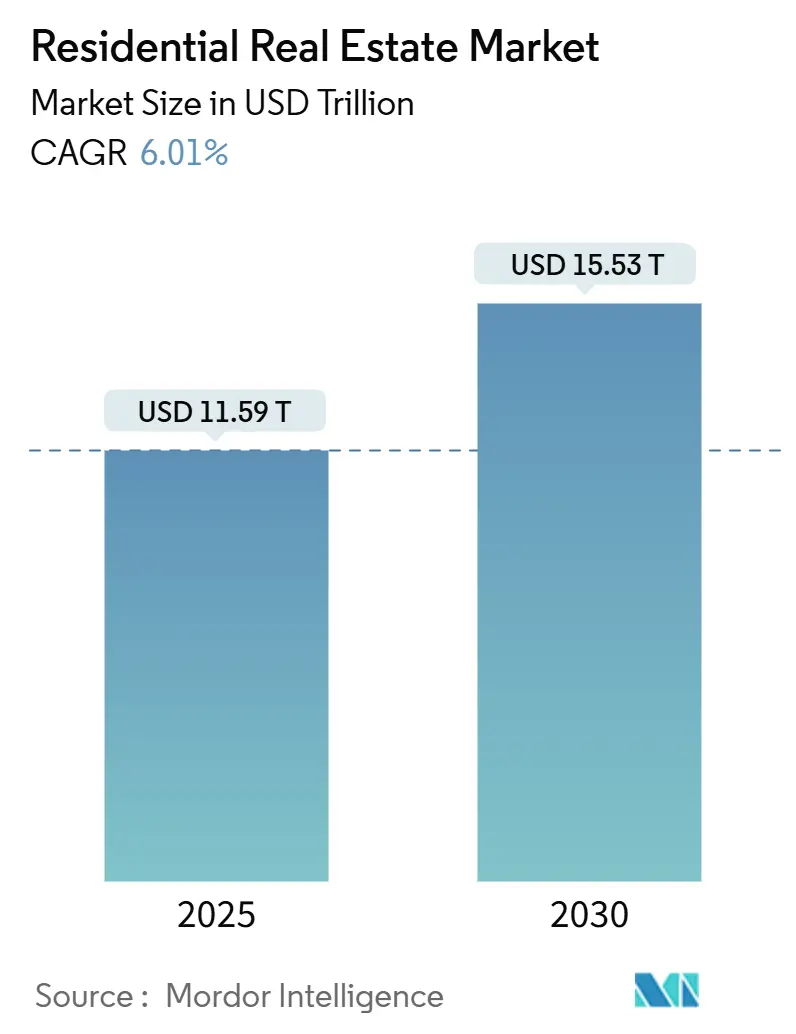
Residential Real Estate Market Analysis by Mordor Intelligence
The Residential Real Estate Market size is estimated at USD 11.59 trillion in 2025, and is expected to reach USD 15.53 trillion by 2030, at a CAGR of 6.01% during the forecast period (2025-2030).
Demographic shifts, persistent supply shortages, and fresh institutional capital are enlarging the addressable pool of buyers and renters. Wealth migration toward tax-advantaged hubs, rising climate-related relocation, and stricter energy-efficiency mandates further reinforce underlying demand. At the same time, labor shortages and material-cost inflation are slowing new-build pipelines, magnifying the premium on ready inventory. Digital platforms that enable fractional ownership and streamlined leasing add liquidity and help global investors participate in residential assets.
Key Report Takeaways
By property type, apartments and condominiums led with 58% revenue share of 2024 in the residential real estate market; villas and landed houses are projected to expand at a 6.19% CAGR to 2030.
By price band, the mid-market segment captured 45% of the global residential real estate market size in 2024, while the luxury tier is advancing at a 6.26% CAGR through 2030.
By business model, secondary transactions accounted for 59% share of the global residential real estate market in 2024, whereas primary new-build development is forecast to grow at 6.61% CAGR.
By mode of sale, ownership sales held 61% share of 2024 in the residential real estate market; rental solutions are forecast to rise at a 6.79% CAGR to 2030.
By geography, Asia-Pacific dominated with 33.10% of global residential real estate market share in 2024 and shows the fastest regional CAGR at 6.91% through 2030.
Global Residential Real Estate Market Trends and Insights
Drivers Impact Analysis
| Driver | % Impact on CAGR Forecast | Geographic Relevance | Impact Timeline |
|---|---|---|---|
| Rapid urbanisation & middle-class expansion | +1.2% | Global, with highest impact in Asia-Pacific and South America | Long term (≥ 4 years) |
| Institutional BTR & SFR capital inflows | +0.8% | North America & Europe, expanding to Asia-Pacific | Medium term (2-4 years) |
| Wealth migration & second-home demand in tax-advantaged hubs | +0.6% | UAE, Switzerland, Portugal, Singapore | Short term (≤ 2 years) |
| Net-zero mandates driving green-retrofit premium | +0.4% | Europe & North America, emerging in Asia-Pacific | Long term (≥ 4 years) |
| Climate-risk migration reshaping housing pipelines | +0.3% | Coastal regions globally, Sun Belt US expansion | Long term (≥ 4 years) |
| Blockchain-enabled fractional ownership | +0.2% | UAE, Europe, select US markets | Medium term (2-4 years) |
| Source: Mordor Intelligence | |||
Rapid urbanisation & middle-class expansion
Emerging cities continue to add residents at rates that outpace historic averages. Every new urban migrant creates multiplier effects on household formation, with estimates suggesting that one arrival eventually stimulates demand for 1.3 housing units through indirect employment gains. Dubai illustrates the pattern: population surpassed 3.8 million in 2024 and 20% year-on-year apartment price growth followed[1]World Bank, “Global Economic Prospects June 2025,” World Bank, worldbank.org. Similar pressure is evident across Latin America where GDP growth is rebounding, lifting disposable incomes and mortgage eligibility. In Asia-Pacific, vertical developments remain the most practical response to land scarcity, reinforcing sustained demand for condominiums. Supply lags are therefore structural rather than cyclical, underpinning long-run price resilience.
Institutional BTR & SFR capital inflows
As conventional office and retail yields compress, large asset managers pivot toward residential strategies. A USD 2.1 billion portfolio purchase by KKR covering 18 Class A multifamily communities signaled confidence in stable cash flows from sun-belt cities[2]KKR & Co. Inc., “KKR Acquires 18-Property Multifamily Portfolio for USD 2.1 Billion,” Investor Relations Press Release, kkr.com. Build-to-rent platforms now command average monthly rents of USD 2,181 and continue to address an estimated 3.9 million-unit shortage in the United States. Europe mirrors the shift: residential assets captured 27% of total property investment by value in 2024, up from 20% three years earlier. Institutional bids compress yields but increase professionally managed stock, enhancing tenant experience and liquidity.
Wealth migration & second-home demand in tax-advantaged hubs
A projected 142,000 millionaires will relocate in 2025, led by inflows to the UAE, Singapore, and Portugal. Concentrated arrivals boost prime-property prices—Dubai luxury homes climbed 15% in 2024 while mid-tier units advanced 17%, a ripple effect from heightened spending capacity. Female investors, set to control USD 34 trillion by 2030, are an emerging force in these purchases, often prioritizing safe jurisdictions and high ESG standards. Secondary demand follows as service-sector staff seek nearby housing, tightening local supply even in middle-income segments.
Net-zero mandates driving green-retrofit premium
Cities are embedding decarbonisation into building codes. Boston requires all new structures above 20,000 sq ft to achieve net-zero emissions from 2025, while New York will phase out fossil-fuel equipment in low-rise builds by 2026[3]Boston Planning & Development Agency, “Zero Net Carbon Building Zoning Update 2025,” BPDA, bostonplans.org. Developers incorporating high-efficiency HVAC and renewable energy recover added costs via premium rents and lower vacancy. Investor scrutiny is tightening too: 80% of Veris Residential’s multifamily portfolio now holds a green certification and the firm targets 50% cuts in Scope 1 and 2 emissions. Properties lacking certification risk accelerated obsolescence.
Restraints Impact Analysis
| Restraint | % Impact on CAGR Forecast | Geographic Relevance | Impact Timeline |
|---|---|---|---|
| Global housing-affordability crisis | -1.8% | Global, most severe in developed markets | Short term (≤ 2 years) |
| Rising policy rates & tighter credit standards | -1.1% | North America & Europe, spreading globally | Medium term (2-4 years) |
| Construction-labour shortages & material-cost volatility | -0.7% | Global, acute in North America and Europe | Long term (≥ 4 years) |
| Hybrid-work vacancy drag in urban cores | -0.4% | Major metropolitan areas globally | Medium term (2-4 years) |
| Source: Mordor Intelligence | |||
Global housing-affordability crisis
In Sydney median house values reached AUD 1.3 million in 2024, driving price-to-income ratios to 16.4 and leaving only 10% of listings affordable for median earners. Canada faces similar stress as mortgage delinquency crept to 0.20% nationally, doubling in Toronto. The United States still confronts a shortfall of up to 3.8 million homes; 45% of renters spend over 30% of income on housing[4]White House, “Housing Supply Action Plan Progress Report 2024,” The White House, whitehouse.gov. Political pressure for subsidised supply is therefore mounting, yet fast-tracked approvals rarely keep pace with demand, capping absorption in entry-level brackets.
Rising policy rates & tighter credit standards
Although the Bank of Canada trimmed its policy rate to 3.25% in 2024, mortgage renewals remain over 200 bps above 2021 lows, pressuring household cash flow[5]Bank of Canada, “Monetary Policy Report Q4 2024,” Bank of Canada, bankofcanada.ca. Eurozone prices pivoted from 7% growth in 2022 to a 1% decline in 2023 as financing costs spiked. US mortgage rates above 6% have pushed many prospective buyers toward rentals and weighed on institutional bulk acquisitions. Banks are tightening loan-to-value thresholds, leaving highly leveraged owners vulnerable to negative equity, particularly where 2021-era prices have retreated.
Segment Analysis
By Property Type: Condominiums command share while villas outpace on growth
Apartments and condominiums controlled 58% of global residential real estate market revenue in 2024, supported by urban density and affordability relative to land-based homes. Demand is strongest in Asia-Pacific capitals where land constraints force vertical solutions and where rapid transit expansions raise condominium values. Dubai’s prime high-rise corridors show transaction volumes rising even as villa prices appreciate faster, underscoring the liquidity of the segment.
The villa and landed-house category is forecast to grow at 6.19% CAGR to 2030 in the residential real estate market. Wealth migration, remote-work flexibility, and post-pandemic lifestyle preferences are driving buyers to larger plots outside congested cores. Institutional investors are also assembling single-family rental portfolios across the United Kingdom and the United States, capitalising on energy-efficient builds that fetch premium rents. Prefabricated construction has cut build times by up to 50%, allowing supply to respond more nimbly. As a result, the global residential real estate market size attached to landed formats is set to expand more rapidly than historical averages.
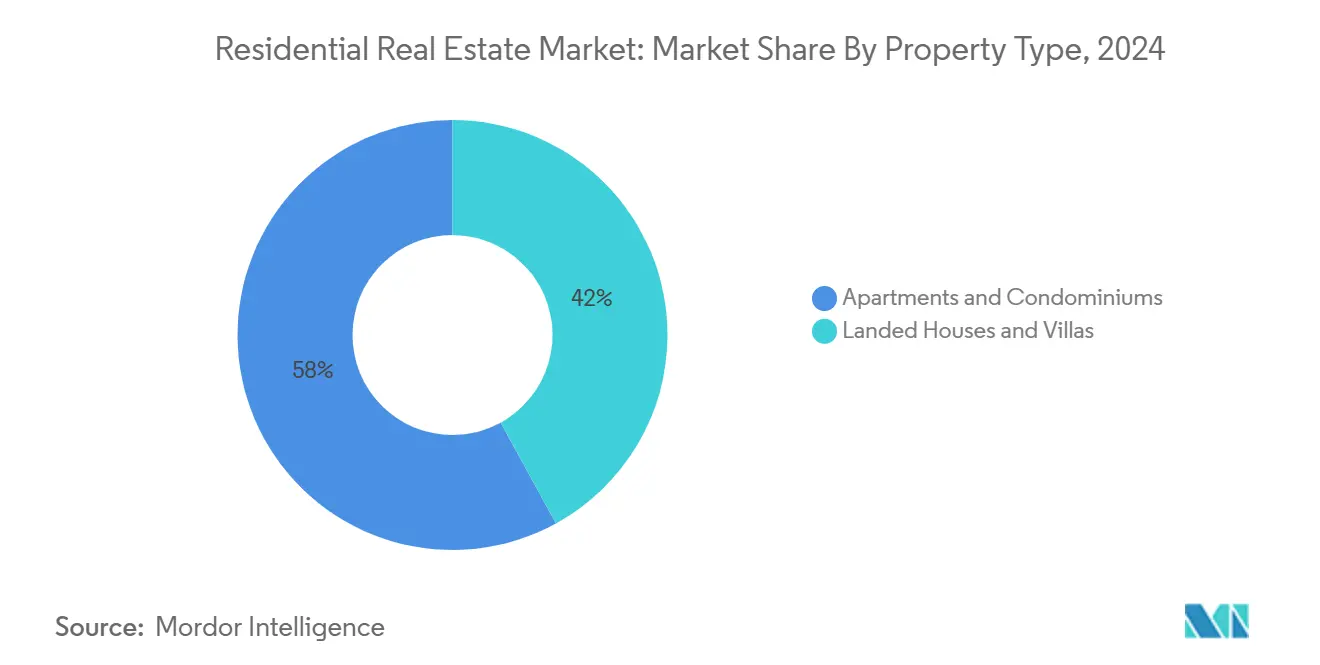
Note: Segment shares of all individual segments available upon report purchase
By Price Band: Mid-market breadth meets luxury acceleration
The mid-market bracket captured 45% of 2024 spending in the residential real estate market, reflecting the sheer volume of households earning close to median wages. Government incentives such as Canada’s 30-year insured mortgage for first-time buyers bolster this tier. Institutional build-to-rent projects often target this affordability band, given its resilient occupancy and predictable cash flows.
Luxury stock, which includes super-prime assets above USD 10 million, is poised for 6.26% CAGR. Dubai led the world in USD 10 million-plus transactions during 2024, while coastal Portugal and alpine Switzerland posted double-digit price gains. Tokenised co-ownership schemes are widening the buyer base and could lift the global residential real estate market share of luxury assets during the forecast horizon. Limited trophy supply and the brand value of marquee destinations underpin further upside.
By Business Model: Secondary liquidity vs primary growth
Secondary transactions represented 59% of turnover in 2024, benefiting from mature inventories and quicker closings. In markets such as Germany, regulatory stringency and energy-performance obligations make refurbishing existing stock more attractive than navigating approvals for new builds.
Primary development, however, should grow 6.61% annually as shortages force governments to fast-track permits. Dream Finders Homes recorded a 40% rise in unit deliveries in Q4-2024 and reported USD 1.5 billion in quarterly revenue. Australia allocated USD 54 million to accelerate modular methods, signalling policy commitment to new stock. The resulting lift in completions enlarges the global residential real estate market size for freshly built product, helping narrow imbalances.
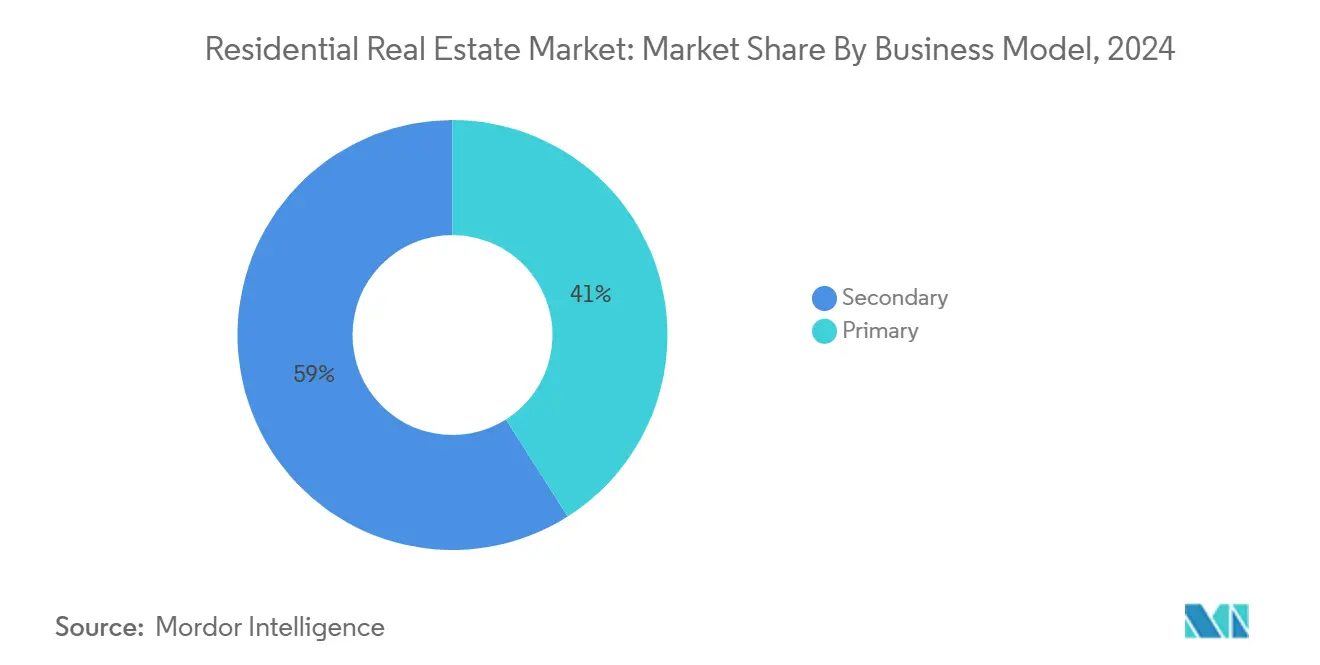
Note: Segment shares of all individual segments available upon report purchase
By Mode of Sale: Ownership dominance gives way to rental momentum
Home sales still made up 61% of 2024 residential real estate market value, reinforced by cultural preferences and tax advantages. Yet elevated mortgage costs are eroding affordability, nudging many households toward long-term renting. Europe forecasts average residential rents to climb 3.2% annually through 2029, outpacing headline inflation. Mid-America Apartment Communities maintained occupancy above 95% and delinquency near 0.3%, illustrating the stability of professional rentals.
Institutional platforms refine the tenant experience with AI lease screening, IoT-enabled maintenance, and dynamic pricing. These efficiencies lower operating costs by up to 25%. Consequently, rental growth at a 6.79% CAGR is set to chip away at the ownership share, reshaping consumer decisions within the global residential real estate market.
Geography Analysis
Asia-Pacific accounted for 33.10% of global residential real estate market revenue in 2024 and is projected to expand at a 6.91% CAGR through 2030. China’s policy support for affordable housing is stabilising sales volumes, while Japan’s multifamily sector benefits from low vacancy and limited new supply. Australia faces acute shortages; median Sydney values reached AUD 1.3 million, prompting a USD 33 billion federal programme that targets 1.2 million new homes in five years[6]Australian Department of the Treasury, “National Housing Accord Implementation Plan 2025,” Australian Government, treasury.gov.au. Transaction volumes picked up in Singapore, Korea, and India, helped by easing border restrictions and increased foreign enrolment in education hubs.
North America maintains a sizeable base but wrestles with affordability and financing headwinds. The United States faces a deficit of up to 3.8 million units, keeping 45% of renters cost-burdened. Canada’s Build Canada Homes vehicle committed more than USD 25 billion to modular construction and aims for 500,000 annual starts. Institutional buyers remain active; KKR’s coastal portfolio acquisition underscores confidence in demographic resilience despite mortgage rate pressure.
Europe shows resilience through robust rental demand. Residential investment volumes rose 33% year-on-year to EUR 47 billion, representing 27% of total real-estate capital flows. Germany may be short more than 1 million units by 2027, with tax incentives lifting investor returns to as much as 25% per year on energy-efficient refurbishments. The UK offers the highest projected total return at 9.8% annually, supported by tight vacancy and upward-trending rents aew.com. In the Middle East, Dubai posted 20% price appreciation and 19% rental growth in 2024 on the back of 6.6% population growth.
South America is regaining momentum in the residential real estate; regional GDP growth is anticipated to improve from 2.2% in 2024 to 2.5% in 2025, led by Argentina’s 3% real-estate expansion outlook. Climate-induced relocations, particularly within Brazil and Chile, are altering internal migration maps and encouraging mixed-use master-planned communities that embed resilience into design standards.
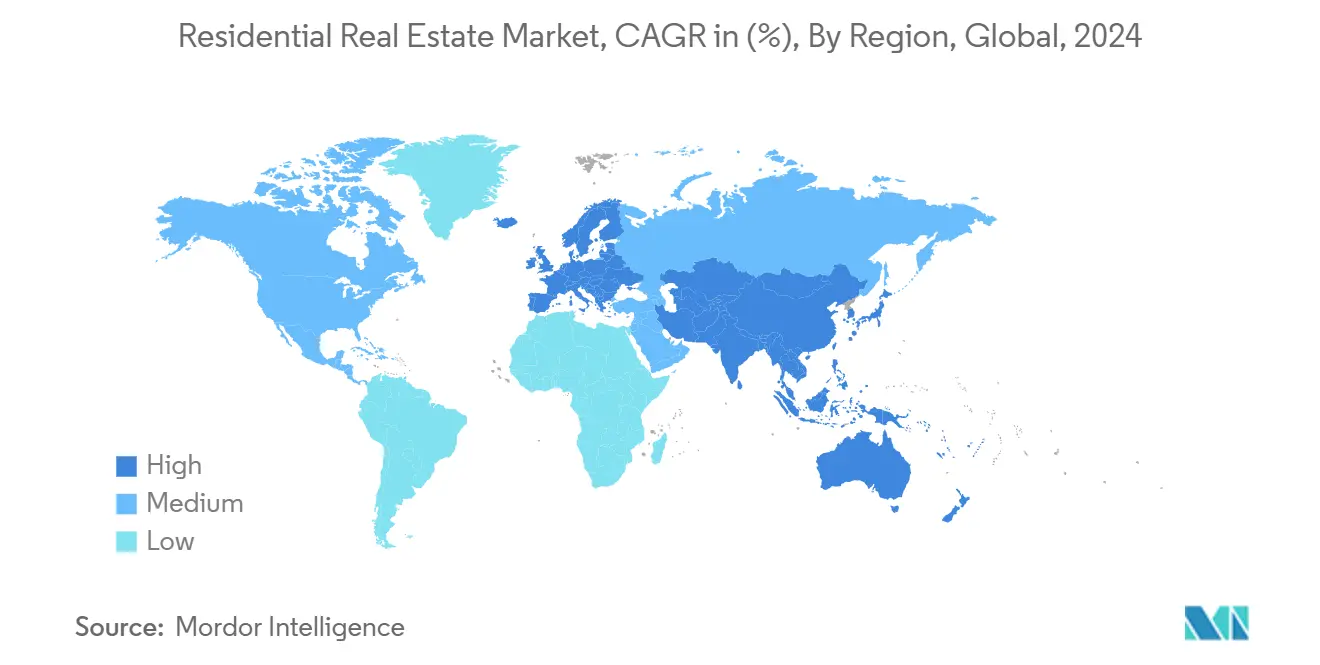
Competitive Landscape
The global residential real estate market remains moderately fragmented but consolidation is accelerating. Apollo agreed to purchase Bridge Investment Group for USD 1.5 billion, boosting assets under management to USD 50 billion and deepening origination in both equity and credit. Rocket Companies finalised a USD 1.75 billion purchase of Redfin, combining mortgage origination with a high-traffic search platform to create an end-to-end ecosystem. Compass, after absorbing @properties and Christie’s International Real Estate for USD 444 million, is negotiating to acquire Berkshire Hathaway’s HomeServices of America, a move that would redefine brokerage scale in the United States.
Technology investment is the main differentiator. PropTech funding reached USD 3.2 billion in 2024, up 18% from the prior year. LeaseAI, Constructify, and PropGreen collectively attracted USD 145 million for AI screening, modular supply-chain optimisation, and energy-performance monitoring. Blockchain pilots in Dubai and Canada illustrate growing comfort with tokenisation; T-RIZE Group alone is converting USD 300 million of Canadian stock into digital shares. Market leaders are therefore racing to integrate data analytics, 3D virtual tours, and end-to-end transaction workflows.
Opportunity white-space is opening in climate-resilient housing, senior living, and co-living communities geared toward urban millennials. Alternative residential property types generated 11.6% annualised returns over the past five years versus 6.2% for mainstream stock. Competitive intensity is expected to rise as private equity dry powder seeks scalable platforms with embedded technology that can deliver both yield and ESG alignment.
Residential Real Estate Industry Leaders
-
Brookfield Residential
-
Lennar Corporation
-
Emaar Properties
-
China Vanke
-
D.R. Horton
- *Disclaimer: Major Players sorted in no particular order
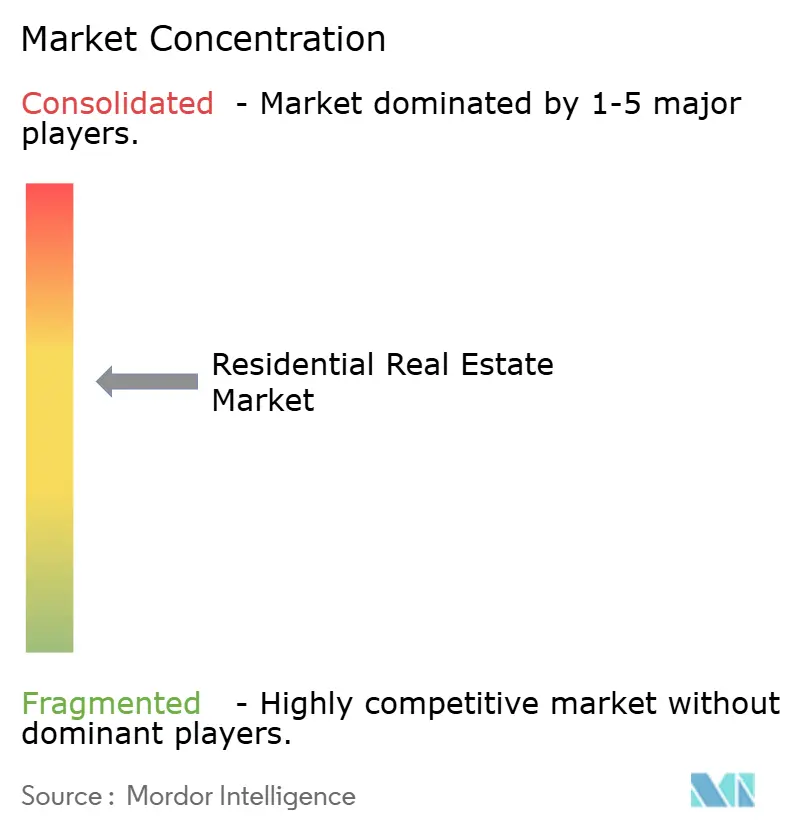
Recent Industry Developments
- June 2025: KKR acquired a USD 2.1 billion multifamily portfolio spanning 5,200 units across 18 Class A properties in California, Florida, and Texas, reinforcing its conviction in high-growth metros.
- May 2025: The European Parliament adopted a coordinated housing framework to align member-state policies on affordability, land-use, and energy performance.
- April 2025: Compass entered advanced talks to purchase Berkshire Hathaway’s HomeServices of America, potentially creating the largest US residential brokerage by transaction volume.
- March 2025: Rocket Companies completed its USD 1.75 billion acquisition of Redfin, forecasting USD 200 million in annual synergies by 2027.
Research Methodology Framework and Report Scope
Market Definitions and Key Coverage
Our study defines the residential real estate market as the annual dollar value of completed ownership transfers and formal rental contracts for dwellings that are legally zoned for human habitation, including single-family houses, villas, townhomes, cooperatives, apartments, and condominiums, across primary (new-build) and secondary (existing-home) channels.
Scope exclusion: Land banking, off-plan raw land deals, timeshares, informal rental agreements, and corporate staff housing lie outside the present scope.
Segmentation Overview
- By Property Type
- Apartments & Condominiums
- Landed Houses & Villas
- By Price Band
- Affordable
- Mid-Market
- Luxury / Super-prime
- By Business Model
- Primary (New-Build)
- Secondary (Existing-home Resale)
- By Mode of Sale
- Sales
- Rental
- By Region
- North America
- United States
- Canada
- Mexico
- South America
- Brazil
- Argentina
- Chile
- Rest of South America
- Europe
- Germany
- United Kingdom
- France
- Italy
- Spain
- Rest of Europe
- Asia-Pacific
- China
- India
- Japan
- South Korea
- Australia
- Rest of Asia-Pacific
- Middle East & Africa
- United Arab Emirates
- Saudi Arabia
- South Africa
- Nigeria
- Rest of Middle East & Africa
- North America
Detailed Research Methodology and Data Validation
Primary Research
Mordor analysts conduct semi-structured interviews and surveys with developers, brokerage heads, mortgage lenders, and institutional landlords across Asia-Pacific, North America, Europe, Latin America, and the GCC. These exchanges validate absorption rates, typical price-per-square-meter bands, build-to-rent yields, and construction lead times, enabling us to refine assumptions that secondary data alone cannot illuminate.
Desk Research
Analysts begin by aggregating publicly available building completions, housing-transaction filings, mortgage-registry feeds, and census-level household data issued by bodies such as the World Bank, UN DESA, the U.S. Census Bureau, Eurostat, and major central banks. Industry associations and housing ministries supply price indices and inventory pipelines, while 10-K filings, investor decks, and press archives accessed through Dow Jones Factiva and D&B Hoovers contextualize corporate exposure. Additional insights come from trade portals, patent trends on prefabrication systems, and customs data on key inputs like cement and steel. This source list is illustrative rather than exhaustive; many other repositories inform the desk review.
Market-Sizing & Forecasting
A top-down model converts national transaction registers and rental-value pools into regional totals, normalized for currency, inflation, and shadow-market leakage. Select bottom-up checks, including developer sales roll-ups, portal traffic-to-closing ratios, and sampled average-selling-price times unit volumes, are then overlaid to reconcile gaps. Key drivers embedded in the model include housing starts, median mortgage rates, urban household formation, construction cost indices, cross-border capital flows, and policy incentives such as first-time-buyer subsidies. Forecasts leverage a multivariate regression blended with ARIMA for price trajectories, producing baseline, conservative, and accelerated scenarios; inputs are benchmarked with expert consensus before finalization.
Data Validation & Update Cycle
Each draft passes a two-level peer review that flags anomalies against macro indicators and independent sector metrics. Discrepancies trigger re-contacts with data owners. The global dataset refreshes annually, with interim flashes when material events, such as rate shocks, major housing programs, or regulatory shifts, alter market direction. Before release, a fresh analyst pass ensures clients receive the most current view.
Why Mordor's Residential Real Estate Baseline Commands Reliability
Published estimates often diverge because firms vary in scope, variable selection, and refresh cadence. Some tally only new-home sales, others track listed property stock, while a few rely on price-index proxies that overlook rental flows.
Key gap drivers include Mordor's inclusion of both rental and ownership turnover, our unit-level currency normalization, and an annual refresh against live transaction feeds; alternate publishers may apply static cost-per-unit multipliers, omit rental value, or update infrequently, leading to sizeable variance.
Benchmark comparison
| Market Size | Anonymized source | Primary gap driver |
|---|---|---|
| USD 11.59 trn (2025) | Mordor Intelligence | |
| USD 10.64 trn (2024) | Global Consultancy A | Excludes rental contracts; relies on regional ASP averages without currency re-indexing |
| USD 1.46 trn (2024) | Trade Journal B | Tracks only professionally managed stock and new completions, omitting secondary sales and informal markets |
Taken together, the comparison shows that while headline numbers vary widely, Mordor's disciplined mix of broad scope, dual-track modeling, and frequent updates provides a balanced, transparent baseline that decision-makers can trace back to clear variables and replicable steps.
Key Questions Answered in the Report
Why is institutional capital moving into housing now?
Institutional investors are reallocating from low-yield commercial assets into the global residential real estate market, where stable occupancy and inflation-linked rent growth promise superior risk-adjusted returns.
Which region offers the strongest near-term growth?
Asia-Pacific leads with a 6.91% CAGR through 2030, supported by urbanisation, rising middle-class incomes, and proactive infrastructure spending recorded across China, India, and Southeast Asia.
How are net-zero rules affecting valuations?
Properties that already meet rigorous efficiency codes command rent and price premiums, while non-compliant stock faces retrofit costs that can erode value, particularly in Europe and North America.
Will higher interest rates derail housing demand?
Tighter credit is slowing ownership transactions but simultaneously boosting rental demand, sustaining overall revenue growth for the global residential real estate market despite headwinds.
How severe is the global housing shortage?
Shortfalls vary by market: the United States lacks up to 3.8 million units, Germany could be short 1 million by 2027, and Australia is targeting 1.2 million new homes in five years, underscoring widespread supply gaps that underpin long-run demand.
Page last updated on:



